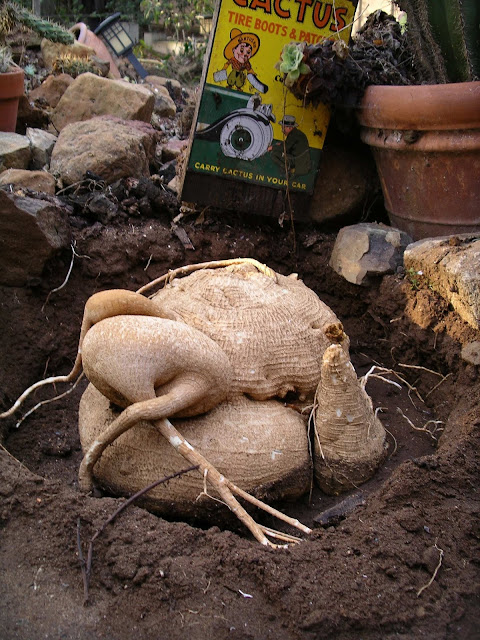Oh well. Everything else around it is fine. Sometimes these things just happen.
Some plants, on the other hand, are doing really well, in particular the Baja plants. My theory is that plants from areas that receive mostly summer rain did especially well this year. An example is Cape Wild-Plum (Cyrtocarpa edulis). It is a Baja endemic from the cape region where most rain falls in summer and there is rarely any winter rain. I bought it as a bare root from Arid Lands Nursery and put it in a medium size container. I wasn't sure at first that it was going to survive. But after this summer it looks fantastic. Other Baja plants such as Fairyduster (Calliandra californica) have done equally well.
This past weekend was the annual plant sale for the San Diego Chapter of CNPS. I pre-ordered a number of plants so that I wouldn't have to fight the crowd on sale day, and this worked out great. Of course, to do this you have to know what you want in advance. It might seem easier to just stroll through the plants on display and pick out whatever appeals to you. But that approach has led me astray in the past when I ended up with plants that ultimately died or performed poorly because they didn't really fit well with my garden. Pre-ordering forced me to really think about what plants I was interested in, research what conditions these plants require, and thus decide where I would plant them. While this is a lot more work upfront, it pays off in results.
Speaking of plant research, CNPS has a new website called Calscape which is a compendium of information about native plants for the garden. It brings together all the best info from books, other web sites, and personal knowledge of expert gardeners. Everyone should check it out.
Here's what I bought at the plant sale:
- Dutchman's Pipe (Aristolochia californica) - Although this attractive vine is native to the northern part of the state, it can do well here in the south with shade and some additional water.
- Indian Milkweed (Asclepias eriocarpa) - Milkweeds are the larval host plant for Monarch butterflies. I like this species because it is native to SD County and is rather showy.
- Summer Holly (Comarostaphylis diversifolia ssp. diversifolia) - I have a mature one of these already and I have a place for another one. This is a rare and beautiful plant.
- Lance-leaf Dudleya (Dudleya lanceolata) - I just can't get enough Dudleyas.
- Alkali Heath (Frankenia salina) - This little ground cover is found around lagoons and salt marsh. I have a spot for it next to my pond.
- Coast Goldenbush (Isocoma menziesii) - I didn't know about this plant prior to doing my research. Now that I know it, it's really perfectly suited for my garden.
- Laurel Sumac (Malosma laurina) - I should have planted this one 20 years ago but for some reason I didn't. Now I finally got one.
- Wild Cucumber (Marah macrocarpus) - I had one of these before that I started from seed. It ended up getting taken out when we remodeled our house in 2011 (see photo below). Since then I've been wanting another one.
- Western Sword Fern (Polystichum munitum) - I already have a couple of these in the shade garden on the north side of the house, but I always want more.
- Blue-eyed Grass (Sisyrinchium bellum) - Like I said, I always want more.
- Mission Manzanita (Xylococcus bicolor) - Like I said...more, more, more.
Okay, now here are some more pictures. First is a picture of the Marah macrocarpus that I had a few years ago. This species forms a huge tuber, and I had to dig up mine because of the remodel we were doing. At the time I dug it up, it was about 5 years old. It weighed about 25 lbs. and here's what it looked like.
Next, the new Summer Holly and the new Mission Manzanita in their new home. They are on the northwest corner of the house where the side yard starts to become the back yard. They will get some shade which will help when they are younger, but they will also get afternoon sun.
Next is the new Laurel Sumac in its new home. I put it in the planter on the southwest corner of the house in the Channel Islands section. It's tiny right now but it's a fast grower and should be up to the top of the fence in a couple of years. Although it is not an island endemic, it is found on Catalina and San Clemente Islands. I plan to shape it as a single trunk tree.
The last of the new plantings (so far) is the Alkali Heath. Although it is very tolerant of saline conditions, it doesn't require that. So it should do okay with a little extra water in this spot next to the pond, if the skunks and possums don't dig them up.
There are a couple of new residents in the garden. One is a big orb-weaving spider, perfect for Halloween. In this photo you can't see the web so it looks like the spider is just hanging in mid-air.
The other new resident is some bizarre kind of fungus. I haven't smelled it, but it must have an odor that attracts flies because they are all over it. And why would a fungus want to attract flies anyway? It's not like it needs to get pollinated. If anyone knows anything about this fungus, please let me know.








No comments:
Post a Comment